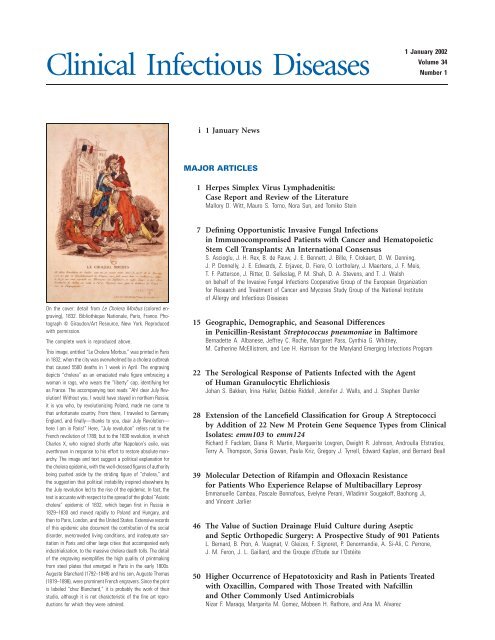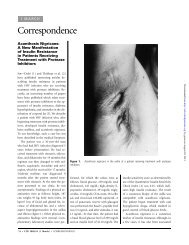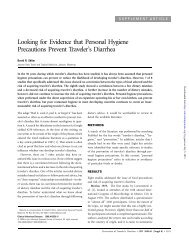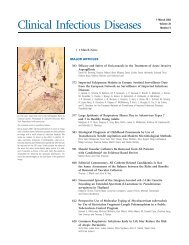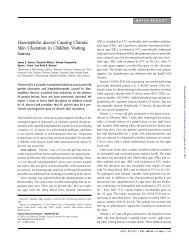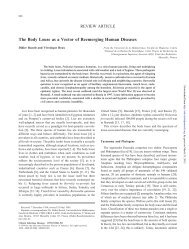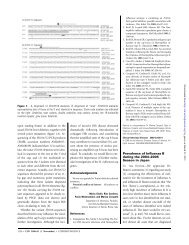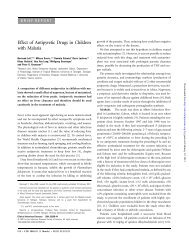Table of Contents (PDF) - Clinical Infectious Diseases
Table of Contents (PDF) - Clinical Infectious Diseases
Table of Contents (PDF) - Clinical Infectious Diseases
You also want an ePaper? Increase the reach of your titles
YUMPU automatically turns print PDFs into web optimized ePapers that Google loves.
<strong>Clinical</strong> <strong>Infectious</strong> <strong>Diseases</strong><br />
On the cover: detail from Le Cholera Morbus (colored engraving),<br />
1832. Bibliothèque Nationale, Paris, France. Photograph<br />
Giraudon/Art Resource, New York. Reproduced<br />
with permission.<br />
The complete work is reproduced above.<br />
This image, entitled “Le Cholera Morbus,” was printed in Paris<br />
in 1832, when the city was overwhelmed by a cholera outbreak<br />
that caused 5500 deaths in 1 week in April. The engraving<br />
depicts “cholera” as an emaciated male figure embracing a<br />
woman in rags, who wears the “liberty” cap, identifying her<br />
as France. The accompanying text reads “Ah! dear July Revolution!<br />
Without you, I would have stayed in northern Russia;<br />
it is you who, by revolutionizing Poland, made me come to<br />
that unfortunate country. From there, I traveled to Germany,<br />
England, and finally—thanks to you, dear July Revolution—<br />
here I am in Paris!” Here, “July revolution” refers not to the<br />
French revolution <strong>of</strong> 1789, but to the 1830 revolution, in which<br />
Charles X, who reigned shortly after Napoleon’s exile, was<br />
overthrown in response to his effort to restore absolute monarchy.<br />
The image and text suggest a political explanation for<br />
the cholera epidemic, with the well-dressed figures <strong>of</strong> authority<br />
being pushed aside by the striding figure <strong>of</strong> “cholera,” and<br />
the suggestion that political instability inspired elsewhere by<br />
the July revolution led to the rise <strong>of</strong> the epidemic. In fact, the<br />
text is accurate with respect to the spread <strong>of</strong> the global “Asiatic<br />
cholera” epidemic <strong>of</strong> 1832, which began first in Russia in<br />
1829–1830 and moved rapidly to Poland and Hungary, and<br />
then to Paris, London, and the United States. Extensive records<br />
<strong>of</strong> this epidemic also document the contribution <strong>of</strong> the social<br />
disorder, overcrowded living conditions, and inadequate sanitation<br />
in Paris and other large cities that accompanied early<br />
industrialization, to the massive cholera death tolls. The detail<br />
<strong>of</strong> the engraving exemplifies the high quality <strong>of</strong> printmaking<br />
from steel plates that emerged in Paris in the early 1800s.<br />
Auguste Blanchard (1792–1849) and his son, Auguste Thomas<br />
(1819–1898), were prominent French engravers. Since the print<br />
is labeled “chez Blanchard,” it is probably the work <strong>of</strong> their<br />
studio, although it is not characteristic <strong>of</strong> the fine art reproductions<br />
for which they were admired.<br />
i 1 January News<br />
MAJOR ARTICLES<br />
1 Herpes Simplex Virus Lymphadenitis:<br />
Case Report and Review <strong>of</strong> the Literature<br />
Mallory D. Witt, Mauro S. Torno, Nora Sun, and Tomiko Stein<br />
1 January 2002<br />
Volume 34<br />
Number 1<br />
7 Defining Opportunistic Invasive Fungal Infections<br />
in Immunocompromised Patients with Cancer and Hematopoietic<br />
Stem Cell Transplants: An International Consensus<br />
S. Ascioglu, J. H. Rex, B. de Pauw, J. E. Bennett, J. Bille, F. Crokaert, D. W. Denning,<br />
J. P. Donnelly, J. E. Edwards, Z. Erjavec, D. Fiere, O. Lortholary, J. Maertens, J. F. Meis,<br />
T. F. Patterson, J. Ritter, D. Selleslag, P. M. Shah, D. A. Stevens, and T. J. Walsh<br />
on behalf <strong>of</strong> the Invasive Fungal Infections Cooperative Group <strong>of</strong> the European Organization<br />
for Research and Treatment <strong>of</strong> Cancer and Mycoses Study Group <strong>of</strong> the National Institute<br />
<strong>of</strong> Allergy and <strong>Infectious</strong> <strong>Diseases</strong><br />
15 Geographic, Demographic, and Seasonal Differences<br />
in Penicillin-Resistant Streptococcus pneumoniae in Baltimore<br />
Bernadette A. Albanese, Jeffrey C. Roche, Margaret Pass, Cynthia G. Whitney,<br />
M. Catherine McEllistrem, and Lee H. Harrison for the Maryland Emerging Infections Program<br />
22 The Serological Response <strong>of</strong> Patients Infected with the Agent<br />
<strong>of</strong> Human Granulocytic Ehrlichiosis<br />
Johan S. Bakken, Irina Haller, Debbie Riddell, Jennifer J. Walls, and J. Stephen Dumler<br />
28 Extension <strong>of</strong> the Lancefield Classification for Group A Streptococci<br />
by Addition <strong>of</strong> 22 New M Protein Gene Sequence Types from <strong>Clinical</strong><br />
Isolates: emm103 to emm124<br />
Richard F. Facklam, Diana R. Martin, Marguerite Lovgren, Dwight R. Johnson, Androulla Efstratiou,<br />
Terry A. Thompson, Sonia Gowan, Paula Kriz, Gregory J. Tyrrell, Edward Kaplan, and Bernard Beall<br />
39 Molecular Detection <strong>of</strong> Rifampin and Ofloxacin Resistance<br />
for Patients Who Experience Relapse <strong>of</strong> Multibacillary Leprosy<br />
Emmanuelle Cambau, Pascale Bonnafous, Evelyne Perani, Wladimir Sougak<strong>of</strong>f, Baohong Ji,<br />
and Vincent Jarlier<br />
46 The Value <strong>of</strong> Suction Drainage Fluid Culture during Aseptic<br />
and Septic Orthopedic Surgery: A Prospective Study <strong>of</strong> 901 Patients<br />
L. Bernard, B. Pron, A. Vuagnat, V. Gleizes, F. Signoret, P. Denormandie, A. Si-Ali, C. Perrone,<br />
J. M. Feron, J. L. Gaillard, and the Groupe d’Etude sur l’Ostéite<br />
50 Higher Occurrence <strong>of</strong> Hepatotoxicity and Rash in Patients Treated<br />
with Oxacillin, Compared with Those Treated with Nafcillin<br />
and Other Commonly Used Antimicrobials<br />
Nizar F. Maraqa, Margarita M. Gomez, Mobeen H. Rathore, and Ana M. Alvarez
55 Effect <strong>of</strong> Changes in Antibiotic Prescribing<br />
on Patient Outcomes in a Community<br />
Setting: A Natural Experiment in Australia<br />
Justin Beilby, John Marley, Don Walker, Nicole Chamberlain,<br />
and Michelle Burke for the FIESTA Study Group<br />
REVIEW ARTICLE<br />
65 Postarthroscopy Surgical Site Infections:<br />
Review <strong>of</strong> the Literature<br />
Hilary M. Babcock, Matthew J. Matava, and Victoria Fraser<br />
VIEWPOINTS<br />
72 “Endgame” Issues for the Global Polio<br />
Eradication Initiative<br />
Technical Consultative Group to the World Health Organization<br />
on the Global Eradication <strong>of</strong> Poliomyelitis<br />
PHOTO QUIZ<br />
78 Complicated Urinary Tract Infection<br />
in a Diabetic Woman<br />
CONFRONTING BIOLOGICAL WEAPONS<br />
79 Countering the Posteradication Threat<br />
<strong>of</strong> Smallpox and Polio<br />
D. A. Henderson<br />
TRAVEL MEDICINE<br />
84 Meningococcal Disease and Travel<br />
Ziad A. Memish<br />
HIV/AIDS<br />
91 Reservoirs <strong>of</strong> Human Immunodeficiency<br />
Virus Type 1: The Main Obstacles<br />
to Viral Eradication<br />
Roger J. Pomerantz<br />
98 Ischemic Cardiovascular Disease in Persons<br />
with Human Immunodeficiency Virus Infection<br />
Max H. David, Richard Hornung, and Carl J. Fichtenbaum<br />
103 Focal Neurological Disease in Patients<br />
with Acquired Immunodeficiency Syndrome<br />
Daniel J. Skiest<br />
116 Detection <strong>of</strong> a Drug-Resistant Human<br />
Immunodeficiency Virus Variant in a Newly<br />
Infected Heterosexual Couple<br />
Laura Romano, Giulietta Venturi, Angela Vivarelli, Luisa Galli,<br />
and Maurizio Zazzi<br />
118 Chagasic Meningoencephalitis in a Patient<br />
with Acquired Immunodeficiency Syndrome:<br />
Diagnosis, Follow-Up, and Genetic<br />
Characterization <strong>of</strong> Trypanosoma cruzi<br />
Eliane Lages-Silva, Luis Eduardo Ramirez, Mario Leon Silva-Vergara,<br />
and Egler Chiari<br />
ANSWER TO PHOTO QUIZ<br />
124 Complicated Urinary Tract Infection<br />
in a Diabetic Woman<br />
CORRESPONDENCE<br />
126 Salmonella typhi in the Past Decade: Learning<br />
to Live with Resistance<br />
Camilla Rodrigues, Ajita Mehta, and V. R. Joshi<br />
127 Schizophrenia and Serological Methods<br />
for Diagnosis <strong>of</strong> Toxoplasmosis<br />
Francis Derouin, Philippe Thulliez, and Stéphane Romand<br />
127 Reply<br />
Robert H. Yolken<br />
129 Rendering Beef Safe<br />
Peter Horby<br />
130 Rotavirus Cerebellitis?<br />
Lise E. Nigrovic, Carey Lumeng, Christopher Landrigan,<br />
and Vincent W. Chiang<br />
130 <strong>Infectious</strong> Disease Pathology and the Autopsy<br />
Kurt B. Nolte<br />
131 Reply<br />
Gary W. Procop<br />
131 Kawasaki-like Syndrome: Abacavir<br />
Hypersensitivity?<br />
Joseph G. Toerner and Therese Cvetkovich<br />
132 Reply<br />
Raymond M. Johnson and Gregory A. Storch
134 ELECTRONIC ARTICLES<br />
Diagnosis <strong>of</strong> Streptococcus pneumoniae Lower<br />
Respiratory Infection in Hospitalized Children<br />
by Culture, Polymerase Chain Reaction,<br />
Serological Testing, and Urinary Antigen<br />
Detection<br />
Ian C. Michelow, Juanita Lozano, Kurt Olsen, Collin Goto,<br />
Nancy K. Rollins, Faryal Ghaffar, Violeta Rodriguez-Cerrato,<br />
Maija Leinonen, and George H. McCracken, Jr.<br />
Immediate Hypersensitivity Reactions after Use<br />
<strong>of</strong> Tuberculin Skin Testing<br />
James E. Froeschle, Frederick L. Ruben, and A. Michael Bloh<br />
Esophageal Ulceration Due to Cytomegalovirus<br />
Infection in a Patient with Acute Retroviral<br />
Syndrome<br />
Nicholas J. Vietri, Peter J. Skidmore, and David P. Dooley<br />
Mycoplasma pneumoniae Pericarditis<br />
Demonstrated by Polymerase Chain<br />
Reaction and Electron Microscopy<br />
Maria Szymanski, Martin Petric, Frederick E. Saunders,<br />
and Raymond Tellier<br />
African Sleeping Sickness in Tourists<br />
Returning from Tanzania: The First 2<br />
Italian Cases from a Small Outbreak<br />
among European Travelers<br />
Diego Ripamonti, Marco Massari, Claudio Arici, Ermanno Gabbi,<br />
Claudio Farina, Maria Brini, Carlo Capatti, and Fredy Suter<br />
Statement <strong>of</strong> Editorial Policy


